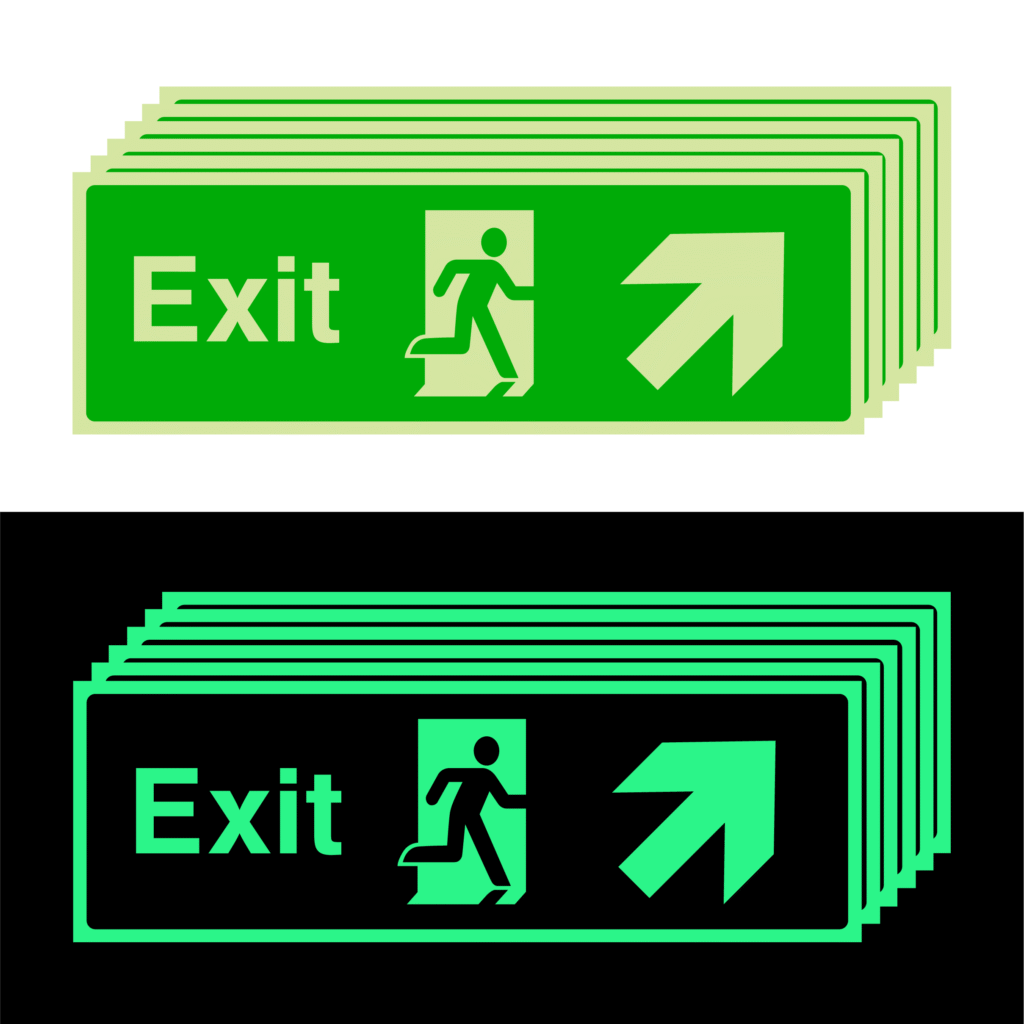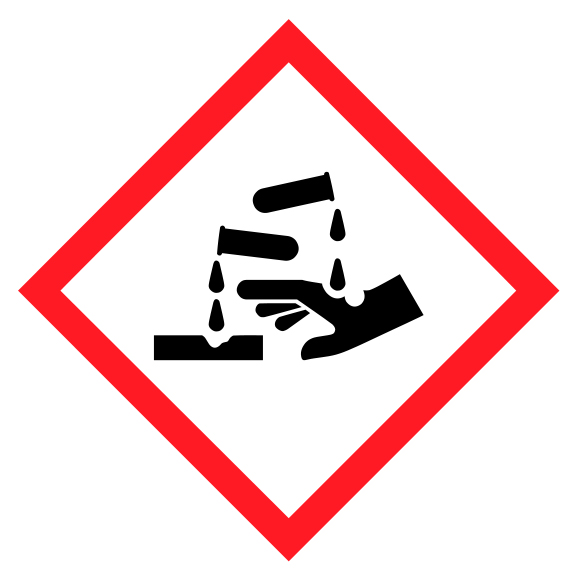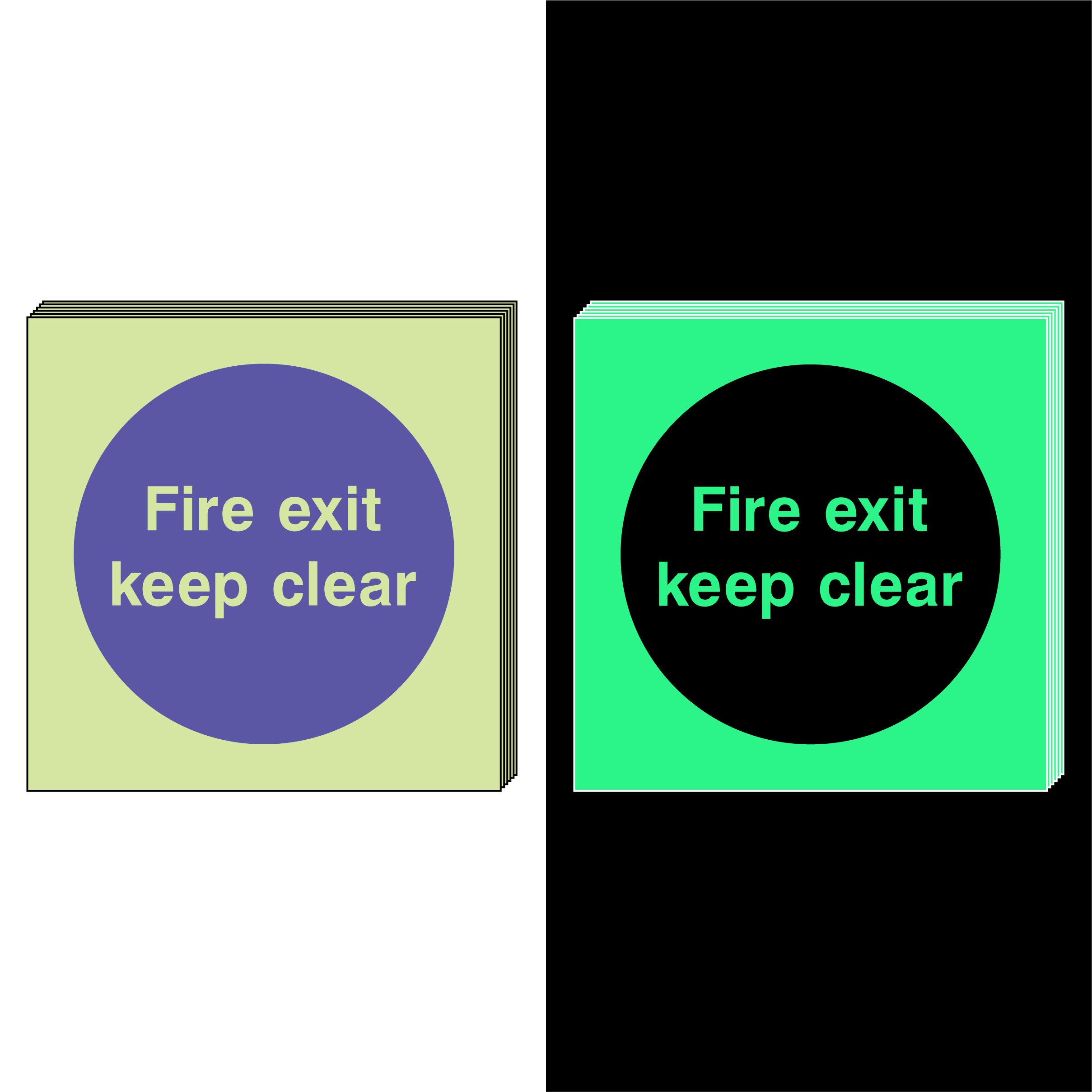Fire safety is a critical component of any building’s design, ensuring that in the event of an emergency, occupants can safely and efficiently evacuate the premises. Traditional safety measures often include illuminated exit signs and clear evacuation routes. However, one technology that has rapidly gained prominence in modern fire strategies is the use of photoluminescent fire exit signs. These signs are not only a reliable and cost-effective solution but also a significant upgrade over traditional illuminated options.
1. What Are Photoluminescent Signs?
Photoluminescent signs are safety signs that glow in the dark, powered entirely by the light they absorb during the day. These signs are typically made from materials that absorb ambient light and then re-emit it as a visible glow when the surrounding light levels drop. Unlike traditional illuminated exit signs that rely on electrical power, photoluminescent signs remain visible even during power failures.
- There are several types of photoluminescent signs, including fire exit signs, directional arrows, floor markings, and emergency exit signs.
- Each of these plays a critical role in guiding individuals to safety in the event of a fire or other emergency situation.
- The signs are often used in areas where visibility is critical, such as corridors, stairwells, and emergency exits.
2. The Role of Photoluminescent Signs in Fire Safety
In an emergency, especially during a fire, one of the most vital components of ensuring safety is the ability to see and follow clear exit routes. Photoluminescent fire exit signs are designed to provide a clear, visible path for occupants to follow in low-light or smoke-filled environments.
The key advantage of these signs is their ability to glow continuously without the need for an external power source. This feature makes them incredibly reliable during a power failure, which is a common occurrence in fires due to electrical malfunctions or damage to the power supply. As such, photoluminescent signs can remain visible even when all other light sources are extinguished, ensuring that people can still safely evacuate the premises.

3. Benefits of Using Photoluminescent Signs
There are numerous advantages to integrating photoluminescent signs into fire safety strategies:
- Long-lasting glow without power: Photoluminescent signs use no electricity, making them cost-effective and reliable. The glow lasts for hours after absorbing ambient light, providing ample time for evacuation.
- Enhanced visibility in emergencies: During smoke-filled fires or power outages, the signs remain visible and act as a clear path to safety.
- Compliance with safety codes: Photoluminescent signs are widely accepted by fire safety regulations and building codes, making them a valuable addition to any safety plan.
- Eco-friendly: Unlike illuminated signs that require electricity to function, photoluminescent signs are energy-efficient and environmentally friendly.
In addition to these practical benefits, photoluminescent signs are also durable, requiring minimal maintenance over their lifespan. This further enhances their appeal to building owners and safety managers.
4. Key Applications of Photoluminescent Signs in Fire Strategies
Photoluminescent signs have a wide range of applications in fire safety strategies. Their primary use is in guiding occupants to safety during an emergency. Some of the most common applications include:
- Fire exits: Photoluminescent fire exit signs are often placed at strategic locations such as hallways and stairwells to direct people toward the nearest exit. These signs glow brightly, making them easily visible even in the midst of smoke or darkness.
- Directional signage: These signs can be used to guide individuals to safety by marking paths and indicating evacuation routes. Floor markings and arrows are commonly placed along the ground to lead people to emergency exits.
- Hazard warnings: Photoluminescent signs can also be used to highlight hazardous areas such as fire escapes, gas pipelines, and electrical rooms, ensuring that individuals avoid these dangerous areas during an evacuation.
- Stairwells and corridors: In tall buildings, photoluminescent signs are particularly useful in stairwells and corridors, where smoke and darkness can impair vision. These signs ensure that individuals can find their way out quickly and safely.
5. Photoluminescent Signs vs. Traditional Fire Signage
Traditional fire exit signs, which often rely on illuminated lighting systems, can be prone to failure in emergency situations. These signs require a power source and may fail during a power outage or be compromised in the event of an electrical malfunction. Once charged with light, they glow continuously for hours without the need for electricity, providing constant illumination even during power outages.
Moreover, photoluminescent signs are more energy-efficient and cost-effective in the long run compared to traditional illuminated exit signs. While they may have a slightly higher initial cost, their long lifespan and zero energy consumption make them a better investment in terms of overall safety and maintenance.

6. Integration into Fire Safety Plans
When integrating photoluminescent signs into fire safety plans, it is crucial to consider their placement to ensure maximum effectiveness. These signs should be placed at key locations such as:
- Exit doors: Near emergency exits to provide clear direction.
- Corridors and stairwells: To ensure individuals can easily follow the route to safety.
- Hazardous areas: To indicate areas that should be avoided during evacuation, such as storage rooms for flammable materials or gas valves.
Dust and dirt can diminish the glow of photoluminescent materials, so regular cleaning is necessary, especially in areas with hazardous materials marked by a corrosive symbol. Additionally, signs should be inspected regularly to ensure that they have absorbed enough light and remain highly visible in emergencies.
7. Compliance with Fire Safety Standards and Regulations
Photoluminescent fire exit signs are widely accepted and mandated by fire safety regulations and building codes in many countries, including the UK. The signs must meet certain standards to ensure their reliability and effectiveness. For example, they must be able to glow for a certain number of hours and be visible from a specified distance.
In addition to meeting regulatory standards, photoluminescent signs help building owners and facility managers ensure compliance with fire safety codes, reducing the risk of penalties and ensuring the safety of occupants.
Conclusion
The integration of photoluminescent fire exit signs into fire safety strategies offers numerous benefits, from improved visibility and energy efficiency to enhanced reliability during power outages and emergencies. These signs provide uninterrupted safety, ensuring that occupants can quickly and safely evacuate a building in the event of a fire or other emergency. At Foamex Printing Company, we understand the importance of incorporating reliable safety solutions into your building’s fire strategy. Our high-quality photoluminescent signs are designed to provide clear, visible guidance in emergencies, ensuring the safety of all occupants.

